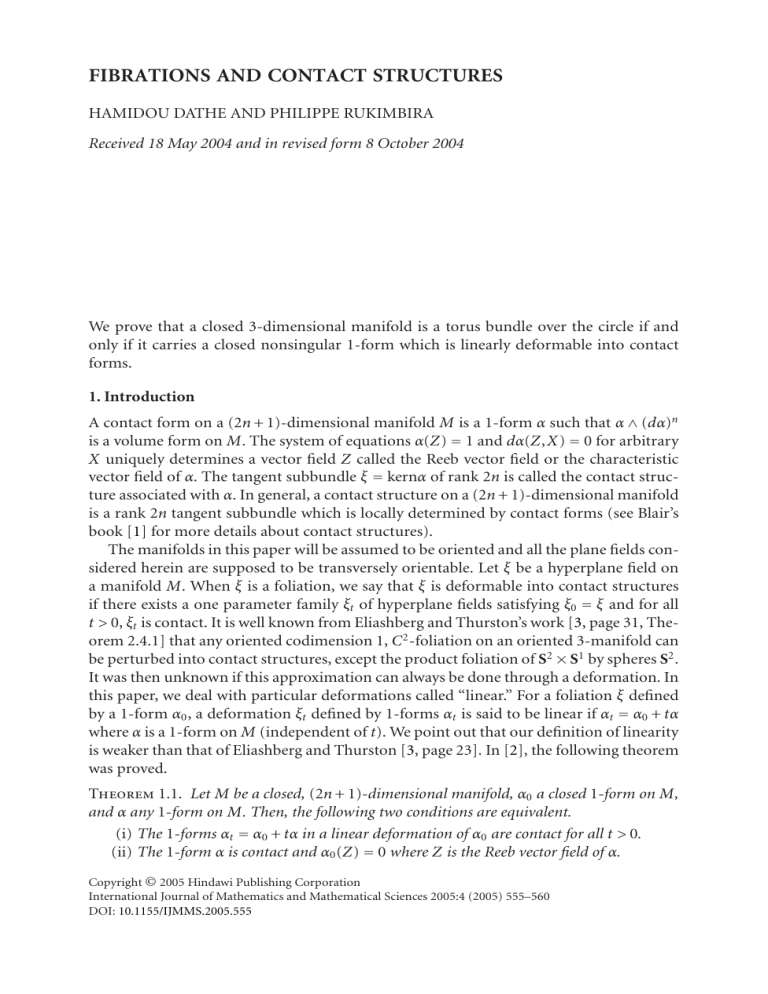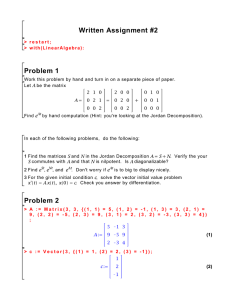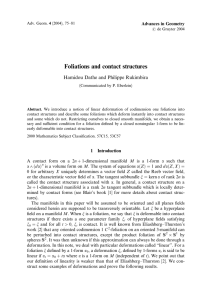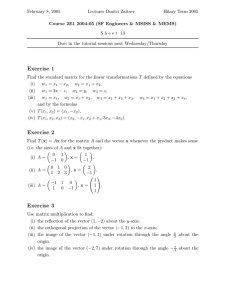FIBRATIONS AND CONTACT STRUCTURES
advertisement

FIBRATIONS AND CONTACT STRUCTURES
HAMIDOU DATHE AND PHILIPPE RUKIMBIRA
Received 18 May 2004 and in revised form 8 October 2004
We prove that a closed 3-dimensional manifold is a torus bundle over the circle if and
only if it carries a closed nonsingular 1-form which is linearly deformable into contact
forms.
1. Introduction
A contact form on a (2n + 1)-dimensional manifold M is a 1-form α such that α ∧ (dα)n
is a volume form on M. The system of equations α(Z) = 1 and dα(Z,X) = 0 for arbitrary
X uniquely determines a vector field Z called the Reeb vector field or the characteristic
vector field of α. The tangent subbundle ξ = kernα of rank 2n is called the contact structure associated with α. In general, a contact structure on a (2n + 1)-dimensional manifold
is a rank 2n tangent subbundle which is locally determined by contact forms (see Blair’s
book [1] for more details about contact structures).
The manifolds in this paper will be assumed to be oriented and all the plane fields considered herein are supposed to be transversely orientable. Let ξ be a hyperplane field on
a manifold M. When ξ is a foliation, we say that ξ is deformable into contact structures
if there exists a one parameter family ξt of hyperplane fields satisfying ξ0 = ξ and for all
t > 0, ξt is contact. It is well known from Eliashberg and Thurston’s work [3, page 31, Theorem 2.4.1] that any oriented codimension 1, C 2 -foliation on an oriented 3-manifold can
be perturbed into contact structures, except the product foliation of S2 × S1 by spheres S2 .
It was then unknown if this approximation can always be done through a deformation. In
this paper, we deal with particular deformations called “linear.” For a foliation ξ defined
by a 1-form α0 , a deformation ξt defined by 1-forms αt is said to be linear if αt = α0 + tα
where α is a 1-form on M (independent of t). We point out that our definition of linearity
is weaker than that of Eliashberg and Thurston [3, page 23]. In [2], the following theorem
was proved.
Theorem 1.1. Let M be a closed, (2n + 1)-dimensional manifold, α0 a closed 1-form on M,
and α any 1-form on M. Then, the following two conditions are equivalent.
(i) The 1-forms αt = α0 + tα in a linear deformation of α0 are contact for all t > 0.
(ii) The 1-form α is contact and α0 (Z) = 0 where Z is the Reeb vector field of α.
Copyright © 2005 Hindawi Publishing Corporation
International Journal of Mathematics and Mathematical Sciences 2005:4 (2005) 555–560
DOI: 10.1155/IJMMS.2005.555
556
Fibrations and contact structures
Using this theorem, we will obtain a characterization of T2 -bundles over S1 .
2. Torus bundles over S1
In dimension 3, one has the following characterization of T2 -bundles over S1 .
Theorem 2.1. Let M be a closed, 3-dimensional manifold. Then the following two conditions are equivalent.
(i) There is on M a closed nonsingular 1-form α0 and a 1-form α such that the 1-forms
αt = α0 + tα in a linear deformation of α0 are contact for all t > 0.
(ii) M is a T2 -bundle over S1 .
Proof. First we prove that (i) implies (ii). If α0 and α are as in (i), then, by Theorem 1.1, α
is a contact form whose characteristic vector field Z satisfies α0 (Z) = 0. Arbitrarily close
to α0 , there is a closed, rational 1-form β which is obtained as follows. By the Hodge-de
Rham theorem, α0 = h + df where h is a harmonic 1-form and f is a smooth function. Let
h1 ,...,hl be a basis of the vector space of harmonic forms on M. Then h = λ1 h1 + · · · +
λl hl where the numbers λi ’s represent the periods of h. One can arbitrarily approximate
each of λi by a rational number qi and consider the 1-form β = q1 h1 + · · · + ql hl + df .
If the approximations qi are close enough, then β is a nonsingular, closed 1-form with
rational periods. The leaves of the foliation kern β form a fibration of M by closed surfaces
Σ over S1 . Let g be any metric on M in which β is of unit length and let N denote the
metric dual unit vector field of β. Let Pr(Z) = Z − β(Z)N be the orthogonal projection
of Z onto kernβ. Suppose that at some point x ∈ M, Pr(Z) = 0. Then, at that point, Z =
β(Z)N and therefore 0 = α0 (Z) = β(Z)α0 (N). If β and α0 are sufficiently close, then α0 (N)
is close to β(N) = 1 and hence α0 (N) = 0, which implies that β(Z) = 0. So, Pr(Z) = 0 at
some point implies that Z = 0 at that particular point, contradicting the fact that Z is
a nonsingular vector field. Therefore, Pr(Z) = Z − β(Z)N is a nonsingular vector field.
Moreover, β(Pr(Z)) = 0, hence Pr(Z) is everywhere tangent to the fiber Σ, which means
that Σ is a 2-torus T2 .
To prove that (ii) implies (i), we will exhibit on every T2 -bundle over S1 a contact form
α whose characteristic vector field Z is tangent to the fibers T2 . α0 can then be taken to be
the pullback of dθ, the volume form on S1 , under the fiber projection map. Suppose that
M is an orientable T2 -bundle over S1 with monodromy A ∈ SL2 Z. Following Geiges and
Gonzalo [5], we consider 3 different cases.
Case 1 (traceA ≥ 3). The manifold M is a left quotient of Sol3 , the solvable Lie group
defined as a split extension of R2 by R. The group R acts on R2 by z · (x, y) = (ez x,e−z y).
Sol3 can be identified with R3 with the following multiplication:
x0 , y0 ,z0 · (x, y,z) = x0 + ez0 x, y0 + e−z0 y,z0 + z .
(2.1)
The bundle projection is given by (x, y,z) → z (see [7]).
On Sol3 , set
α = cos
2πn
2πn
z e−g(z) dx − sin
z eg(z) d y,
γ
γ
(2.2)
H. Dathe and P. Rukimbira 557
n ∈ N, g is a smooth, monotone increasing function that satisfies
(i) g(z) = z near z = 0,
(ii) g(z) = γ/2 near z = γ/2,
(iii) g(z + γ) = g(z) + γ for all z.
The 2-form dα is given by
2πn
2πn
2πn
sin
z e−g(z) + g (z)e−g(z) cos
z dz ∧ dx
dα = −
γ
γ
γ
2πn
2πn
2πn
−
cos
z eg(z) + g (z)eg(z) sin
z dz ∧ d y,
γ
γ
γ
2πn
2πn
2πn
+ g (z)cos
z sin
z dx ∧ d y ∧ dz.
α ∧ dα =
γ
γ
γ
(2.3)
Since the coefficient in α ∧ dα is bigger than 2πn/γ − g (z), one sees that for n large so that
2nπ/γ − g (z) > 0, α defines a contact form on Sol3 that is invariant under Γ, the discrete
subgroup generated by elements of the form (α1 ,β1 ,0), (α2 ,β2 ,0), (0,0,γ). Moreover, the
characteristic vector field Z of the induced contact form is given by
F(x, y,z)∂x + G(x, y,z)∂y
(2.4)
for some functions F and G on M. Therefore, Z is tangent to the fibers of the projection
map Sol3 → Γ\Sol3 .
Case 2 (traceA<−3). The manifold M is diffeomorphic to a quotient of the form Γ\Sol3
where Γ is generated by elements (α1 ,β1 ,0),(α2 ,β2 ,0) in Sol3 and a generator (see [4])
(x, y,z) −→ − eγ x, −e−γ y,z + γ .
(2.5)
Set
nπz −g(z)
nπz g(z)
e
dx − sin
e dy
α = cos
γ
γ
(2.6)
for odd n. The same calculations as in the previous case show that α induces a contact
form on Γ\Sol3 whose characteristic vector field is tangent to the fibers of the projection
map.
Case 3 (the trace of the monodromy matrix A satisfies | trace A| ≤ 2). In this case (see
[6]), either A is a periodic matrix or it is conjugate to ±Ak ,
1 k
,
Ak =
0 1
k ∈ Z/ {0}.
(2.7)
558
Fibrations and contact structures
Subcase 1 (A is conjugate to Ak ). The manifold M is a left quotient of Nil3 . Nil3 can be
thought of as R3 with the multiplication
x0 , y0 ,z0 · (z, y,z) = x0 + x, y0 + y,z0 + z + x0 y .
(2.8)
Every compact left quotient of Nil3 is diffeomorphic to one of the form Γk \Nil3 , k ∈
Z/ {0}, where Γk is generated by elements (k,0,0),(0,1,0),(0,0,1). The left quotients are
precisely the T2 -bundles over S1 with monodromy Ak , the bundle projection being given
by (x, y,z) → y.
Set
α = cos(2π y)dx − sin(2π y) dz − f (x)d y ,
(2.9)
where f is a smooth, monotone increasing function that satisfies
(i) f (x) = x near x = 0,
(ii) f (x) = k/2 near x = k/2,
(iii) f (x + k) = f (x) + k for all x.
One sees that dα is given by
dα = −2π sin(2π y)d y ∧ dx − 2π cos(2π y)d y ∧ dz + f (x)sin(2π y)dx ∧ d y,
α ∧ dα = − 2π + f (x)sin2 (2π y) dx ∧ d y ∧ dz.
(2.10)
Since 2π + f (x)sin2 (2π y) is strictly positive, the 1-form α induces a contact form on
Γk \Nil3 whose characteristic vector field Z is given by
F(x, y,z)∂x + G(x, y,z)∂z
(2.11)
for some functions F and G on M. Z is therefore tangent to the fibers of the T2 fibration.
Subcase 2 (T2 -bundles over S1 with periodic monodromy). These are compact left
quotients of E2 , the universal cover of the group of Euclidean motions in the plane.
The Lie algebra of E2 admits a basis {e1 , e2 , e3 } with brackets [e1 ,e2 ] = 0, [e3 ,e1 ] = e2 ,
[e2 ,e3 ] = e1 .
Let ω1 ,ω2 ,ω3 be the dual coframe of left invariant 1-forms on E2 . ω1 and ω2 are contact
forms, ω3 is a closed 1-form. The foliation defined by ω3 passes down to any left quotient
of E2 into the fibration by T2 . Each of the contact forms ω1 , ω2 passes down to the T2 bundle, with characteristic vector field tangent to the fibers T2 .
On a T2 -bundle over S1 , it is not just the pullback of the volume form on S1 that is
linearly deformable into contact forms. One has the following proposition.
Proposition 2.2. Let M be a T2 -bundle over S1 . Then any rational, nonsingular, closed
1-form on M is linearly deformable into contact forms.
Proof. Let α0 be a rational, nonsingular, closed 1-form on M. α0 defines a Σ-fibration of
M over S1 , where Σ is a closed surface. Since the homotopy groups π p (S1 ) are trivial for
p ≥ 2, the homotopy exact sequences of the two fibrations contain the following short
H. Dathe and P. Rukimbira 559
exact sequences:
0 −→ π1 (Σ) −→ π1 (M) −→ Z −→ 0,
0 −→ π1 T2 −→ π1 (M) −→ Z −→ 0.
(2.12)
It follows that Σ has to be a torus. The rest of the proof is as the proof of (ii) implies
(i) from Theorem 2.1.
Corollary 2.3. Any fibration over the circle S1 on the three-dimensional torus T3 is linearly
deformable into contact structures.
In [2], we give an example of transversely affine foliation which is linearly deformable
into contact structures. Here, we will prove the following generalization of this example.
Proposition 2.4. On a three dimensional closed manifold, every transversely affine foliation of codimension 1 with holonomy is linearly deformable into contact structures.
Proof. The proof is based on the principe of deforming a foliation near a curve of nontrivial holonomy (see [3]). It is known that (see [8]) a transversely affine foliation with
nontrivial holonomy on a compact manifold has only finitely many compact leaves and
each of them has nontrivial holonomy, hence a curve with nontrivial holonomy.
A natural question is the following: can one generalize Theorem 1.1 to all transversely
affine foliations? The answer is no. Here is a counterexample.
Let M be a T2 -bundle over the circle with monodromy A satisfying Tr A > 2. M can
be identified with some left quotient of Sol3 (see notations in the proof of Theorem 2.1,
Case 1). Let λ be the eigenvalue of A such that λ > 1, u and v the eigenvectors corresponding to λ and 1/λ.
On Sol3 , set the vector fields X = −1/(Logλ)∂/(∂z), Y = λ−z u, and Z = λz v. These
vector fields induce three vector fields on M also denoted by X, Y , Z and which satisfy
the identities [X,Y ] = Y , [X,Z] = −Z, [Y ,Z] = 0. The duals of these vector fields are
nonsingular 1-forms ω1 , ω2 , and ω3 satisfying dω1 = 0, dω2 = ω1 ∧ ω2 , and dω3 = −ω1 ∧
ω3 . Let Ᏺ denote the codimension 1 foliation defined by kern ω2 . Ᏺ is a transversely affine
foliation on M. For all t ≥ 0, the 1-forms αt = ω2 + tω3 define a linear deformation of Ᏺ
into contact structures; but the 1-form ω3 is not contact.
References
[1]
[2]
[3]
[4]
[5]
D. E. Blair, Riemannian Geometry of Contact and Symplectic Manifolds, Progress in Mathematics, vol. 203, Birkhäuser Boston, Massachusetts, 2002.
H. Dathe and P. Rukimbira, Foliations and contact structures, Advances in Geometry 4 (2004),
no. 1, 75–81.
Y. M. Eliashberg and W. P. Thurston, Confoliations, University Lecture Series, vol. 13, American
Mathematical Society, Rhode Island, 1998.
H. Geiges, Symplectic structures on T 2 -bundles over T 2 , Duke Math. J. 67 (1992), no. 3, 539–
555.
H. Geiges and J. Gonzalo, Contact circles on 3-manifolds, J. Differential Geom. 46 (1997), no. 2,
236–286.
560
[6]
[7]
[8]
Fibrations and contact structures
K. Sakamoto and S. Fukuhara, Classification of T 2 -bundles over T 2 , Tokyo J. Math. 6 (1983),
no. 2, 311–327.
P. Scott, The geometries of 3-manifolds, Bull. London Math. Soc. 15 (1983), no. 5, 401–487.
B. Seke, Sur les structures transversalement affines des feuilletages de codimension un, Ann. Inst.
Fourier (Grenoble) 30 (1980), no. 1, 1–29 (French).
Hamidou Dathe: Département de Mathématique, Physique et Informatique, Faculté des Sciences
et Techniques, Université Cheikh Anta Diop (UCAD), Dakar, Senegal
E-mail address: hdathe@ucad.sn
Philippe Rukimbira: Department of Mathematics, Florida International University, Miami, FL
33199, USA
E-mail address: rukim@fiu.edu





